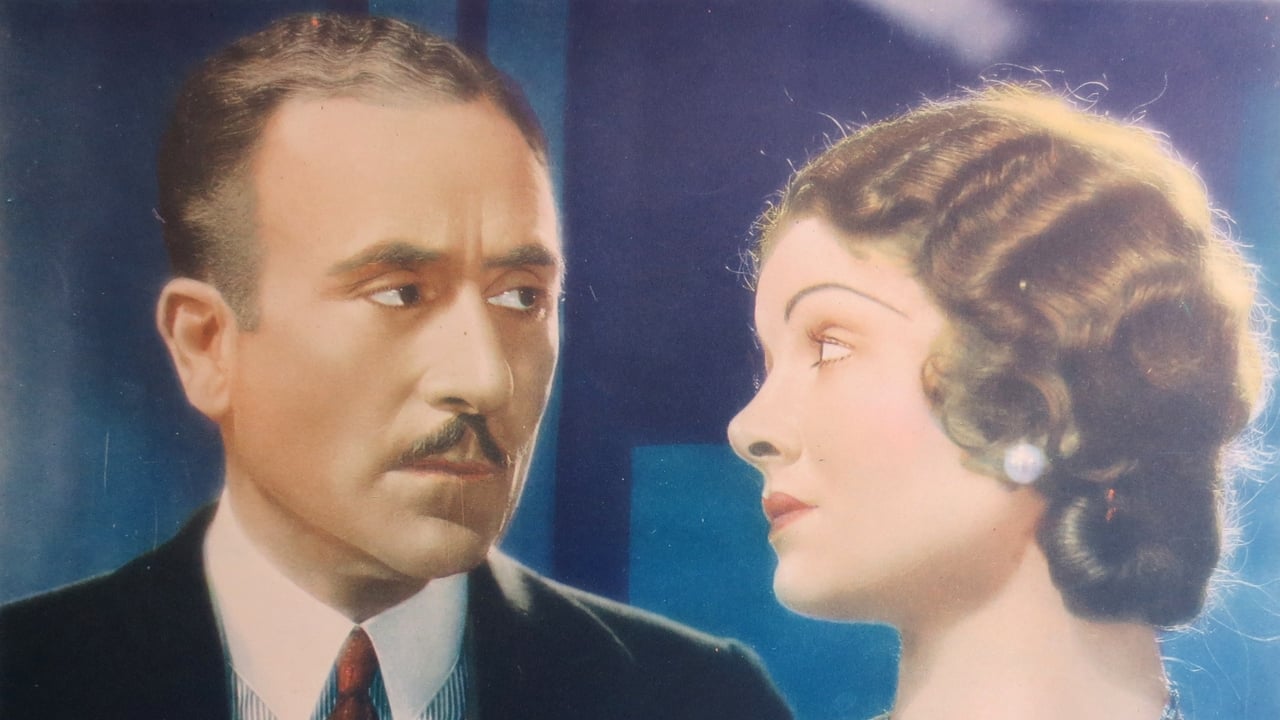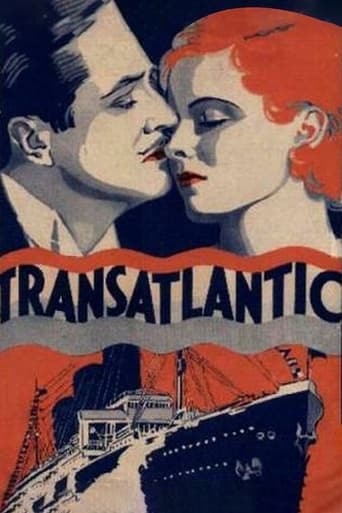Stometer
Save your money for something good and enjoyable
SoftInloveRox
Horrible, fascist and poorly acted
Matialth
Good concept, poorly executed.
Brendon Jones
It’s fine. It's literally the definition of a fine movie. You’ve seen it before, you know every beat and outcome before the characters even do. Only question is how much escapism you’re looking for.
wmorrow59
Let me begin by thanking everyone involved in the recent rescue and restoration of this film. Like so many releases from the Fox Studio, 'Transatlantic' in its original form was lost to posterity due to a 1937 film vault explosion in New Jersey. The original negative was destroyed, and for many years the only known surviving print was one found in Europe, dubbed in French. The credits and all written inserts (newspaper headlines, etc.) were in French as well. But in recent years an almost complete audio recording of the English language soundtrack was recovered, and subsequently new credits and inserts were created which closely match the originals. 'Transatlantic' is once more being screened in a version fairly close to its original release print. Unfortunately, a few random moments of the soundtrack remain missing, but those brief passages have been bridged by subtitles.
Was all this effort worthwhile? Absolutely! 'Transatlantic' is a terrific movie, a first rate popcorn flick, especially impressive as a product of the early talkie era. If you didn't know it was produced in 1931 you'd guess it was done much later: the editing tempo is brisk, camera work is smooth and unconstrained, and the performances are sharp. There's no sign of the slow pacing or awkwardness one sometimes finds in films of this era. The opening sequence, when the ship where most of the action takes place sets sail, serves as an exciting, beautifully edited introduction to our main characters. And once the voyage is underway, several storylines are deftly juggled, in a tight scenario that builds to a genuinely suspenseful finale.
As others have mentioned, this is essentially 'Grand Hotel' on the high seas. (It was produced the year before MGM's famous film, but two years after the publication of that film's source novel.) Edmund Lowe plays Monty Greer, a character rather like John Barrymore's familiar jewel thief. He's a debonair gambler, embarking on this voyage one step ahead of the law, but we know he's a decent sort because he refuses to throw in with a gang of ruthless crooks also on board the ship. They've set their sights on wealthy financier Henry Graham (John Halliday), who has absconded with funds one step ahead of his bank's failure. Graham, for his part, keeps his wife Kay (Myrna Loy) at a distance while he steps out with his mistress Sigrid (Greta Nissen), who is also on board. Sigrid, as it happens, was formerly on intimate terms with Monty. He, meanwhile, befriends kindly old Mr. Kramer (Jean Hersholt) who has worked hard for many years as a lens grinder while raising his daughter Judy (Lois Moran). At long last Mr. Kramer is able to retire and travel-but his life's savings are kept in Henry Graham's bank, and its failure, which Kramer hears about during the voyage, means that he's wiped out.
Those are the central plot threads. It may sound complicated, but it all unfolds neatly and clearly as the ship sails on. There are occasional touches of comedy relief as well, frequently provided by a steward named Hodgkins (played by silent comedy veteran Billy Bevan), whose conversation consists of windy, oft-repeated platitudes. And, as noted above, the various story threads build to a highly suspenseful climax, a shoot-out in the ship's boiler room that is a dazzling cinematic tour-de-force. Kudos to director William K. Howard, cinematographer James Wong Howe, and editor Jack Murray for their work on this film. And again, many thanks to the restoration artists who helped make this delightful flick available once more!
JohnHowardReid
Edmund Lowe (Monty Greer), Lois Moran (Judy Kramer), John Halliday (Henry Graham), Greta Nissen (Sigrid Carline), Jean Hersholt (Rudolph Kramer), Myrna Loy (Kay Graham), Earl Foxe (Handsome), Billy Bevan (Hudgins), Goodee Montgomery (Peters), Jesse De Vorska (buyer), Claude King (captain), Crauford Kent (first officer), Rosalie Roy (bride), Ruth Donnelly (Burbank), Eddie Borden (interloper), James Kirkwood (Sigrid's beau), Jack Lowe (waiter), Henry Sedley (Chalky), Larry Steers (passenger), Louis Matheaux (henchman), Edmund Mortimer (guest), Bob Montgomery (Socker).Director: WILLIAM K. HOWARD. Screenplay: Guy Bolton and Lynn Starling. Original screen story: Guy Bolton. Photography: James Wong Howe. Film editor: Jack Murray. Art director: Gordon Wiles. Stills: Clarence Sinclair Bull.
Copyright 10 July 1931 by Fox Film Corp. New York opening at the Roxy, 30 July 1931. 6,627 feet. 73½ minutes.SYNOPSIS: A Grand Hotel on an ocean liner.NOTES: Academy Award, Art Direction, Gordon Wiles (defeating A Nous la Liberte and Arrowsmith).COMMENT: Photographer Jimmy Howe was once asked by an eager film student in the late 1960s, to name the director Howe regarded as the most skillful, the most talented, the most inventive and the most accomplished in the entire American film industry. Jimmy had worked for many great directors. The eager student expected him to nominate Martin Ritt, Howard Hawks, Raoul Walsh, or perhaps John Frankenheimer. To the student'sutter amazement, Howe unhestitatingly answered, "William K. Howard." Would you believe, the student had never even heard of William K. Howard? Sad, but true! Well, here in "Transatlantic", we find Howard at the zenith of his powers. In fact, "Transatlantic" is a superbly beautiful film in every respect. Even Edmund Lowe (under Howard's sympathetic direction) gives a thoroughly convincing performance.Enough said! I don't want to detail all this film's merits. I would rather you seek it out and watch it yourself!
kidboots
Lois Moran may have been F. Scott Fitzgerald's inspiration for Rosemary, the sweet starlet in "Tender is the Night" but it is a pity she didn't inspire studio bosses to find her better movies. Samuel Goldwyn discovered her in Paris and bought her to Hollywood where she was given the role of Laurel in "Stella Dallas". Apart from that and "Transatlantic" she appeared in no other films of note but the next year (1932) she was on Broadway starring in George Gershwin's "Of Thee I Sing" and the sequel "Let Them Eat Cake". Broadway saw something that had alluded Hollywood.In a terrific long panning shot, all the bustle of boarding a huge ocean liner is depicted - from the taxis pulling up, everyone streaming through the entrances, the baggage trolleys, even a little stray dog (looked a lot like Asta) and all the crew working to get the liner off to a smooth start. Jed Kramar (Jean Hersholt) confides to his daughter Judy (Lois Moran) that this will be the start of a new life for them, Monty Greer (Edmund Lowe) is on the run from the police and in the next cabin, Kay Graham (Myrna Loy, spelt Mirna in the credits) is promising her insufferable husband Henry (John Halliday) that she will try to be more cordial to his mistress, Sigrid (Greta Nissen) next time she pops into their cabin.Linking the main characters is Monty - he accidentally makes the acquaintance of Kay while looking for his bag, he already knows Sigrid and tries to convince her to leave Henry to his wife, Kay, who loves him very much. A robbery is being planned and Graham, a successful banker, is the target. Even though news has just come through that his bank has failed, Graham is not bothered as he is fleeing the country with most of the securities and money he could lay his hands on. Kramar, a depositer with the bank, is ruined but when he tries to confront Graham, he is thrown out like a piece of riff raff. An attempt is made on Graham's life and both Kramar and Greer are held on charges of attempted murder.With a plot very reminiscent of "Grand Hotel" (and seeing that Vicki Baum published her novel in 1929, this maybe the first (although slight) adaptation of it) with Edmund Lowe (substituting for John Barrymore) as the debonair thief willing to lend a helping hand to anyone in distress, especially Myrna Loy (substituting for Greta Garbo) as the let down wife, the real star of "Transatlantic" is the atmospheric cinematography of James Wong Howe and the magnificent sets. Fox, more than any of the other major studios, embraced the Expressionism that came out of European movies of the 20s and "Transatlantic" had a very Continental air about it. The film credits and even various newspaper clippings that appeared throughout the film were in French. Also it helped that there were no big name stars - Edmund Lowe, Lois Moran, Greta Nissen, John Halliday, Myrna Loy (when she was still a supporting player) all gave the movie a European feel.Highly, Highly Recommended.
c532c
Made in the early-morning of talking pictures, this belies any notion you might have of early talkies, with fast editing, a deleriously moving camera, and sharp script. Sets are magnificent, with the luxury liner where the action takes place assuming the atmosphere of some Byzantine palace. Best of all, it's capped off with a tour-de-force cat-and-mouse shoot-out through the vast engine room, which James Wong Howe's photography turns into a visual wonderland-maze of catwalks, huge machines and glossy steam. Script, story and playing are all top-notch.

